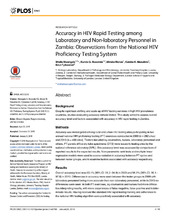| dc.contributor.author | Mwangala, Sheila Monde | en_US |
| dc.contributor.author | Musonda, Kunda G. | en_US |
| dc.contributor.author | Monze, Mwaka | en_US |
| dc.contributor.author | Musukwa, Katoba K. | en_US |
| dc.contributor.author | Fylkesnes, Knut | en_US |
| dc.date.accessioned | 2017-03-17T14:07:08Z | |
| dc.date.available | 2017-03-17T14:07:08Z | |
| dc.date.issued | 2016-01-08 | |
| dc.Published | PLoS ONE 2016, 11(1):e0146700 | eng |
| dc.identifier.issn | 1932-6203 | |
| dc.identifier.uri | https://hdl.handle.net/1956/15600 | |
| dc.description.abstract | Background: Despite rapid task-shifting and scale-up of HIV testing services in high HIV prevalence countries, studies evaluating accuracy remain limited. This study aimed to assess overall accuracy level and factors associated with accuracy in HIV rapid testing in Zambia. Methods: Accuracy was investigated among rural and urban HIV testing sites participating in two annual national HIV proficiency testing (PT) exercises conducted in 2009 (n = 282 sites) and 2010 (n = 488 sites). Testers included lay counselors, nurses, laboratory personnel and others. PT panels of five dry tube specimens (DTS) were issued to testing sites by the national reference laboratory (NRL). Site accuracy level was assessed by comparison of reported results to the expected results. Non-parametric rank tests and multiple linear regression models were used to assess variation in accuracy between PT cycles and between tester groups, and to examine factors associated with accuracy respectively. Results: Overall accuracy level was 93.1% (95% CI: 91.2–94.9) in 2009 and 96.9% (95% CI: 96.1–97.8) in 2010. Differences in accuracy were seen between the tester groups in 2009 with laboratory personnel being more accurate than non-laboratory personnel, while in 2010 no differences were seen. In both PT exercises, lay counselors and nurses had more difficulties interpreting results, with more occurrences of false-negative, false-positive and indeterminate results. Having received the standard HIV rapid testing training and adherence to the national HIV testing algorithm were positively associated with accuracy. Conclusion: The study showed an improvement in tester group and overall accuracy from the first PT exercise to the next. Average number of incorrect test results per 1000 tests performed was reduced from 69 to 31. Further improvement is needed, however, and the national HIV proficiency testing system seems to be an important tool in this regard, which should be continued and needs to be urgently strengthened. | en_US |
| dc.language.iso | eng | eng |
| dc.publisher | PLOS | eng |
| dc.rights | Attribution CC BY | eng |
| dc.rights.uri | http://creativecommons.org/licenses/by/4.0 | eng |
| dc.title | Accuracy in HIV rapid testing among laboratory and non-laboratory personnel in Zambia: Observations from the national HIV proficiency testing system | en_US |
| dc.type | Peer reviewed | |
| dc.type | Journal article | |
| dc.date.updated | 2016-12-13T10:46:09Z | |
| dc.description.version | publishedVersion | en_US |
| dc.rights.holder | Copyright 2016 The Author(s) | |
| dc.identifier.doi | https://doi.org/10.1371/journal.pone.0146700 | |
| dc.identifier.cristin | 1389881 | |

